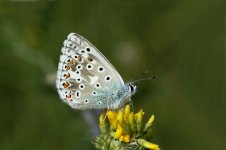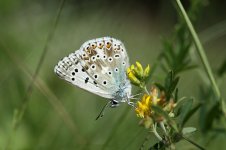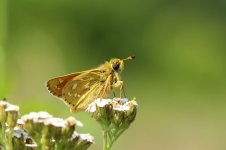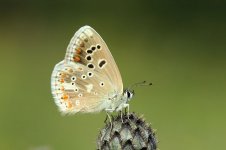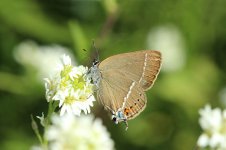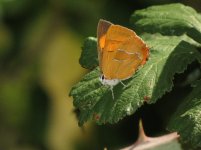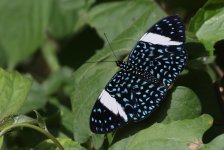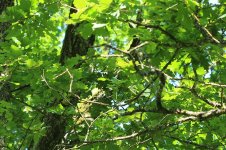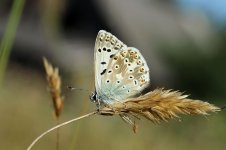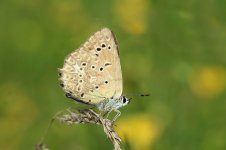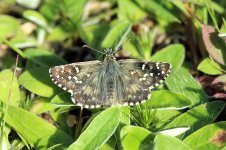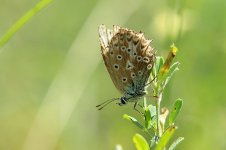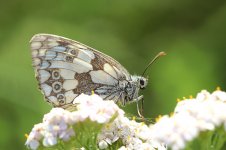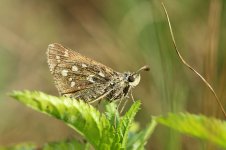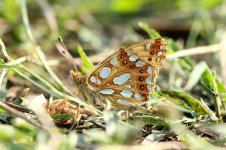
-
Welcome to BirdForum, the internet's largest birding community with thousands of members from all over the world. The forums are dedicated to wild birds, birding, binoculars and equipment and all that goes with it.
Please register for an account to take part in the discussions in the forum, post your pictures in the gallery and more.
You are using an out of date browser. It may not display this or other websites correctly.
You should upgrade or use an alternative browser.
You should upgrade or use an alternative browser.
Baltic Butterfly Challenge 2017 (1 Viewer)
- Thread starter Jos Stratford
- Start date
More options
Who Replied?
RafaelMatias
Unknown member

Brown Hairstreak is still some weeks away up here - not an easy species, but best chances later in August.
A photo of the beast attached. Not sure why Tolman & Lewington needed to state specifically "Absent from Portugal" when coverage is so low around here.
Any suggested target total?
I take implicitly from that question that you'd actually take the challenge? B
I've been trying to find a WP butterfly list to no avail. Then, following Tolman & Lewington only I get a total of 438 species as below:
Papilionidae: 12
Pieridae: 49
Lycaenidae: 120
Riodinidae: 1
Libytheinae: 1
Danainae: 2
Nymphalinae: 71
Satyrinae: 137
Hesperiidae: 45
Total: 438
You can easily add at least 150 species more, from WP areas not covered there (including Iran), and some splits not considered by T & L, and get to a figure roughly in the order of 600 species. Finding which authority to follow would be a first challenge actually!
I guess the level of difficulty is considerably higher here than on a WP birding year and reaching 400 species would be already an absolutely amazing mark, IMO (but I might be underestimating one's determination!... and pocket size
Attachments
RafaelMatias
Unknown member

Here's the bombastic bit, or at least bombastic for me ...
20-23 July. March of the Colonists.
Amongst my highlights back in 2016 were the findings of a couple of Meleager's Blues and a population of at least 65 Marbled Whites in Lithuania, the first species having never been recorded in the Baltic States before, while records of the latter were limited to three individuals in the 1920s and a single in 2001.
As for 2017, simply amazing! From pretty good numbers on 9 July, numbers then mushroomed! Clouds of Marbled Whites drifting across the meadows on 20 June – a staggering sight, an absolute minimum of 260 at a single locality, the flower meadows chock-a-block with the chequered wings, dozens clustering around thistle heads, dozens more floating across the sunny slopes. Adding nearby localities, the total was in excess of 325, truly impressive. In reality, the numbers could have been far higher, yet more Marbled Whites disappearing off into the distance. Numbers had dropped a little by the 23rd, the total across the sites being about 240, but still most impressive, truly a massive population expansion and clear signs of a successful colonisation of the country by this attractive species.
No less impressive Meleager's Blue – I was very happy to relocate this butterfly this year, finding first a male and female on 20 July in the same general area as the previous year, then a very welcome four males and a female on the 23rd. Not in a single cluster, but scattered across flower-rich habitat, it would appear that Meleager's Blues have indeed established themselves at this locality, the total of nine individuals (2016 and 2017) covering an area about 1.5 km across. More remarkable, I also found three males and a female on flowers at a completely new locality, meadows located over 40 kilometres north! So there we have it, the march of the colonists, both species strengthening their footholds in Lithuania, becoming part of the country's butterfly fauna.
However these days were not only about Marbled Whites and Meleager's Blues, it was truly a phenomenal little period, almost 50 species recorded and some in fabulous numbers. Following on from their good numbers in spring, the second generation of Swallowtails is doing even better, 51 individuals logged in just three days, including a very nice 24 at one site, my personal best ever single locality count in Lithuania. Many hundreds of Brimstones emerging, so too Small Whites and Green-veined Whites, Scarce Coppers and Map Butterflies still in their hundreds, Ringlets and both Chestnut and Pearly Heaths still abundant. Though numbers significantly down, still nine species of fritillary on the wing, one Queen of Spain Fritillary and Niobe Fritillary amongst them, as well as a couple of Spotted Fritillaries.
And in with this lot, plenty of top class butterflies amongst the supporting cast – 22 Blue-spot Hairstreaks logged (again including a personal best locality count – 14 at one site), eight Large Coppers, a bunch of Short-tailed Blues, two Little Blues, three Geranium Arguses, one Camberwell Beauty, a huge numbers of Dusky Meadow Browns (another personal best, 60+ at a single locality) and, particularly nice, five Silver-spotted Skippers.
And final highlight, my 100th species of the year in Lithuania, the first three Chalkhill Blues of the year. Finale to an excellent few days!
BALTIC YEAR LIST
98. Silver-spotted Skipper
99. Meleager's Blue
100. Chalkhill Blue
All great stuff! Witnessing range expansion happening before your eyes is something remarkable. I guess 1 or 2 papers/short notes are on their way? Were there deep changes in land use recently (that might have expanded the area of suitable food grasses)?
And 60+ species in a single locality is definitely impressive anywhere.

Were there deep changes in land use recently (that might have expanded the area of suitable food grasses)?
No, land use is basically unchanged in this area, at least in the last decade - abandoned meadow/low intensity use meadow. Potentially part of the answer is that the species have been going undetected earlier, but this is hard to imagine for the very visible Marbled White - even just myself I have visited the area in the past without seeing any and, after first discovering them last year, I subsequently visited the area extensively ...from the total of 65, which I thought was impressive, clearly numbers have soared to this year's massive totals.
As for Meleager's Blue, it would seem there has been a clear increase this year, but I suspect this has quite probably been overlooked - for a species that does strike me as highly mobile/dispersive (as Marbled White could be), my discovery of several at a locality 40 km further north suggests to me these have not colonised merely in the last two years.
birdmeister
Well-known member

19 July. Not the Bombastic Bit.
Was looking for Silver-spotted Skipper and Rock Grayling, both of which would be new for the year, failed in both - but did find my 97th species of the year, perhaps a few days earlier than I was expecting, one Large Grizzled Skipper. Also interesting, I also found a very faded Woodland Brown, not only late in the season, but at a locality where I have never seen the species before.
BALTIC YEAR LIST
97. Large Grizzled Skipper
First of all, this thread is a great read for me. I am always looking for more!
Here in Pennsylvania we have a Silver-spotted Skipper that is very different from the one in your picture! Is it called by a different name in Europe?

Here in Pennsylvania we have a Silver-spotted Skipper that is very different from the one in your picture! Is it called by a different name in Europe?
Indeed your Silver-spotted Skipper is a different species - Epargyreus clarus. The skipper in Europe that carries the name Silver-spotted Skipper is Hesperia comma, which does occur in North America, but under the name Common Branded Skipper.
birdmeister
Well-known member

Indeed your Silver-spotted Skipper is a different species - Epargyreus clarus. The skipper in Europe that carries the name Silver-spotted Skipper is Hesperia comma, which does occur in North America, but under the name Common Branded Skipper.
I see. Thanks very much for clearing that up for me. I looked at your picture and did a bit of a double-take when I saw the label "silver-spotted skipper"!
lewis20126
Well-known member
An enjoyable thread as always Jos,
I cannot comment much on Baltic butterflies but have started trying to identify (with the help of others), some of the amazing butterflies on my foreign jaunts. This one is a real cracker - in fact the beautifully named 'Starry Night Cracker', photographed a few weeks ago in Peru, although it occurs all the way up to Colombia at least (Trevor Ellory images on Surfbirds). I still prefer Purple Emperors though
Anyway, back to the Baltic..
cheers, alan
I cannot comment much on Baltic butterflies but have started trying to identify (with the help of others), some of the amazing butterflies on my foreign jaunts. This one is a real cracker - in fact the beautifully named 'Starry Night Cracker', photographed a few weeks ago in Peru, although it occurs all the way up to Colombia at least (Trevor Ellory images on Surfbirds). I still prefer Purple Emperors though
Anyway, back to the Baltic..
cheers, alan
Attachments

29-30 July. March of the Colonists, Part Two.
I had planned to go to the Tatra Mountains this weekend, I had even departed and begun the long overnight drive. An hour down the road however, with the thought of another ten hours beginning to lose its appeal, a new idea popped into my head – back to the lands of the colonists. With excellent weather forecast, I would conduct a count of Marbled Whites and Meleager's Blues across their localities, exploring adjacent meadows for any additional new populations. What a good decision it turned out to be!
29 July – my single most productive day of the year in Lithuania, notching up exactly 50 species, a total I rarely achieve in this country. Having stayed in a local hotel, I was on site at my favoured locality just as it was warming up, hordes of Marbled Whites already sitting on flower tops taking in the sun. The next few hours were phenomenal – exploring an adjacent area that I had never visited before (having wrongly assumed it was completely forested), I quickly realised it was every bit as good as the core area: diverse flower meadows, rich woodland edge and butterflies galore! Hundreds and hundreds of generation two Brimstones and Peacocks, plus the usual array of abundant Scarce Coppers, Map Butterflies, Small Whites et al, but so too oodles of Marbled Whites. With the habitat quite linear, counting was relatively easy – no less than 215 Marbled Whites in this sector alone!
Even better however, more Meleager's Blues – as it was only a kilometre or so from the original localities of the previous year, I had hoped to find a few here, but what I did not expect was my biggest numbers to date! Two discreet colonies separated by a few hundred metres, the first contained 10 males and two females, while the next was even more impressive with a staggering 13 males and 10 females! Also noteworthy, abundant Chalkhill Blues too, a loose colony of about 65 decorating the short turf. Truly it was a case of butterflies everywhere, added attractions including a couple of Camberwell Beauties, three Little Blues, my first Reverdin's Blue of the year and several Mazarine Blues.
After a brief coffee back at the car, I then walked the remainder of the locality, i.e. the area that I have covered before. A couple of Swallowtails drifted by, a half dozen Blue-spot Hairstreaks sat atop flowers, one Silver-spotted Skipper appeared on a grass stalk, a Large Copper graced a flower bank. Thousands of Brimstones on the wing, hundreds of newly-emerged Peacocks, numerous Scarce Coppers and Map Butterflies, plus Essex Skippers in good numbers, Small Skippers less so. In contrast to all other fritillaries, Dark Green Fritillaries seemed in increased numbers, same too Speckled Woods, at least ten of these active at forest edge. As for the colonists, I added another 295 Marbled Whites to the day tally, plus Meleager's Blues in four separate areas, each some hundreds of metres apart – five males at one place, two males and a female at the next, a single male at the third and a male and a female at the last.
Totalling up the numbers for the locality as a whole, I was blown away – an approximate 510 Marbled Whites and 46 Meleager's Blues, almost surreal numbers that would have been just laughable a mere two years earlier.
Superb stuff, and still plenty of time left to check other sites for further Marbled Whites et al. Wasted some of this time searching for non-existent meadows and exploring tracks that went nowhere, but was soon at another of my regular localities ...again quite amazing numbers of Peacocks and Brimstones, thistle patches absolutely brimming with them! Also, in the course of a couple of kilometres, 17 Swallowtails, several super-fresh Camberwell Beauties, my first Rock Grayling of the year and yet another batch of Chalkhill Blues, a loose colony of about 16 this time. Also 10 Short-tailed Blues, a late White Admiral and again quite a few newly-emerged Dark Green Fritillaries amongst their more tattered kin. More Marbled Whites too - split between a couple of adjacent sites, added another 65 Marbled Whites to the day's tally. This number increased even more with the exploration of further meadows - not massive numbers, but frequently a few here and a few there ...seems the entire southern border zone has been colonised to some degree. Equally nice, also found my first Brown Hairstreak of the season, plus a Large Grizzled Skipper, several Pale Clouded Yellows, more Blue-spot Hairstreaks and a couple of Red Admirals.
Quite enough for one day, not only 50 species noted, including the mega numbers of Marbled Whites and Meleager's Blues, but three new for the year too.
30 July - exploration of localities 20-40 km north for any signs of spread of the colonists. Began at the site where I'd found four Meleager's Blues a week earlier (three males and a female). Very nice habitat - on a gentle slope, short turf meadow on sandy soils at the top, generously laced with flowers, gradually transforming into a richer traditional hay meadow at the bottom. Arrived at 8.30 a.m., immediately impressed with the numbers of Chalkhill Blues - several dozen sunning on grass stalks and flowers. Plenty of Dusky Meadow Browns too, and in not too long a time at all, refound Meleager's Blues at the same spot as the week before - managed two females and a male this time, so a total population of at least five at this locality. It was the Chalkhill Blues however that were the real stars however, loads and loads of them across the short turf areas. A very localised species in Lithuania, they occur at scattered sites in the south, but this number was looking quite amazing ...after a walking transects of the area, I ended up with an estimated total of 425. That is about 410 more than I saw in all of the 2016 season!
Camberwell Beauties and Swallowtails active again, also one Reverdin's Blue. No Marbled Whites to report, so moved onto my next destination, more meadows about a half hour drive away. Climbing to 27 C now, quite humid too. Walked a few kilometres in prime butterfly habitat, the abundant Peacocks and Brimstones of the day before evident here too, so too a whole bunch of fairly local species, these including five Blue-spot Hairstreaks, one Large Copper, a single late Knapweed Fritillary, eight Spotted Fritillaries and two Silver-spotted Skippers. And, there fluttering across a slope, three Marbled Whites.
At a number of additional sites I failed to find anymore. At the final locality that I visited, a traditional area good for whites, many hundreds of Small Whites and Green-veined Whites were flying, smaller numbers of Large Whites and Eastern Bath Whites too, but scan and wander the area as much as I did, still no sign of further Marbled Whites. So this year at least, it would seem that the colonisation is basically very much restricted to the extreme southern border area, very few appearing to have moved more than a handful of kilometres north.
Succumbed to laziness in the heat of the afternoon, quitting in the early afternoon. 47 species seen this day, a grand total of 55 over the two days.
BALTIC YEAR LIST
101. Brown Hairstreak
102. Reverdin's Blue
103. Rock Grayling
.
I had planned to go to the Tatra Mountains this weekend, I had even departed and begun the long overnight drive. An hour down the road however, with the thought of another ten hours beginning to lose its appeal, a new idea popped into my head – back to the lands of the colonists. With excellent weather forecast, I would conduct a count of Marbled Whites and Meleager's Blues across their localities, exploring adjacent meadows for any additional new populations. What a good decision it turned out to be!
29 July – my single most productive day of the year in Lithuania, notching up exactly 50 species, a total I rarely achieve in this country. Having stayed in a local hotel, I was on site at my favoured locality just as it was warming up, hordes of Marbled Whites already sitting on flower tops taking in the sun. The next few hours were phenomenal – exploring an adjacent area that I had never visited before (having wrongly assumed it was completely forested), I quickly realised it was every bit as good as the core area: diverse flower meadows, rich woodland edge and butterflies galore! Hundreds and hundreds of generation two Brimstones and Peacocks, plus the usual array of abundant Scarce Coppers, Map Butterflies, Small Whites et al, but so too oodles of Marbled Whites. With the habitat quite linear, counting was relatively easy – no less than 215 Marbled Whites in this sector alone!
Even better however, more Meleager's Blues – as it was only a kilometre or so from the original localities of the previous year, I had hoped to find a few here, but what I did not expect was my biggest numbers to date! Two discreet colonies separated by a few hundred metres, the first contained 10 males and two females, while the next was even more impressive with a staggering 13 males and 10 females! Also noteworthy, abundant Chalkhill Blues too, a loose colony of about 65 decorating the short turf. Truly it was a case of butterflies everywhere, added attractions including a couple of Camberwell Beauties, three Little Blues, my first Reverdin's Blue of the year and several Mazarine Blues.
After a brief coffee back at the car, I then walked the remainder of the locality, i.e. the area that I have covered before. A couple of Swallowtails drifted by, a half dozen Blue-spot Hairstreaks sat atop flowers, one Silver-spotted Skipper appeared on a grass stalk, a Large Copper graced a flower bank. Thousands of Brimstones on the wing, hundreds of newly-emerged Peacocks, numerous Scarce Coppers and Map Butterflies, plus Essex Skippers in good numbers, Small Skippers less so. In contrast to all other fritillaries, Dark Green Fritillaries seemed in increased numbers, same too Speckled Woods, at least ten of these active at forest edge. As for the colonists, I added another 295 Marbled Whites to the day tally, plus Meleager's Blues in four separate areas, each some hundreds of metres apart – five males at one place, two males and a female at the next, a single male at the third and a male and a female at the last.
Totalling up the numbers for the locality as a whole, I was blown away – an approximate 510 Marbled Whites and 46 Meleager's Blues, almost surreal numbers that would have been just laughable a mere two years earlier.
Superb stuff, and still plenty of time left to check other sites for further Marbled Whites et al. Wasted some of this time searching for non-existent meadows and exploring tracks that went nowhere, but was soon at another of my regular localities ...again quite amazing numbers of Peacocks and Brimstones, thistle patches absolutely brimming with them! Also, in the course of a couple of kilometres, 17 Swallowtails, several super-fresh Camberwell Beauties, my first Rock Grayling of the year and yet another batch of Chalkhill Blues, a loose colony of about 16 this time. Also 10 Short-tailed Blues, a late White Admiral and again quite a few newly-emerged Dark Green Fritillaries amongst their more tattered kin. More Marbled Whites too - split between a couple of adjacent sites, added another 65 Marbled Whites to the day's tally. This number increased even more with the exploration of further meadows - not massive numbers, but frequently a few here and a few there ...seems the entire southern border zone has been colonised to some degree. Equally nice, also found my first Brown Hairstreak of the season, plus a Large Grizzled Skipper, several Pale Clouded Yellows, more Blue-spot Hairstreaks and a couple of Red Admirals.
Quite enough for one day, not only 50 species noted, including the mega numbers of Marbled Whites and Meleager's Blues, but three new for the year too.
30 July - exploration of localities 20-40 km north for any signs of spread of the colonists. Began at the site where I'd found four Meleager's Blues a week earlier (three males and a female). Very nice habitat - on a gentle slope, short turf meadow on sandy soils at the top, generously laced with flowers, gradually transforming into a richer traditional hay meadow at the bottom. Arrived at 8.30 a.m., immediately impressed with the numbers of Chalkhill Blues - several dozen sunning on grass stalks and flowers. Plenty of Dusky Meadow Browns too, and in not too long a time at all, refound Meleager's Blues at the same spot as the week before - managed two females and a male this time, so a total population of at least five at this locality. It was the Chalkhill Blues however that were the real stars however, loads and loads of them across the short turf areas. A very localised species in Lithuania, they occur at scattered sites in the south, but this number was looking quite amazing ...after a walking transects of the area, I ended up with an estimated total of 425. That is about 410 more than I saw in all of the 2016 season!
Camberwell Beauties and Swallowtails active again, also one Reverdin's Blue. No Marbled Whites to report, so moved onto my next destination, more meadows about a half hour drive away. Climbing to 27 C now, quite humid too. Walked a few kilometres in prime butterfly habitat, the abundant Peacocks and Brimstones of the day before evident here too, so too a whole bunch of fairly local species, these including five Blue-spot Hairstreaks, one Large Copper, a single late Knapweed Fritillary, eight Spotted Fritillaries and two Silver-spotted Skippers. And, there fluttering across a slope, three Marbled Whites.
At a number of additional sites I failed to find anymore. At the final locality that I visited, a traditional area good for whites, many hundreds of Small Whites and Green-veined Whites were flying, smaller numbers of Large Whites and Eastern Bath Whites too, but scan and wander the area as much as I did, still no sign of further Marbled Whites. So this year at least, it would seem that the colonisation is basically very much restricted to the extreme southern border area, very few appearing to have moved more than a handful of kilometres north.
Succumbed to laziness in the heat of the afternoon, quitting in the early afternoon. 47 species seen this day, a grand total of 55 over the two days.
BALTIC YEAR LIST
101. Brown Hairstreak
102. Reverdin's Blue
103. Rock Grayling
.
Last edited:

1-7 August.
As finally Lithuania experienced something akin to proper summer weather, I spent a few days trying to find the localised Arran Brown - probably too late in the season and probably not at good localities, needless to say I didn't find any! I did however find four Large Wall Browns, individuals right at the end of their flight season. Biggest surprise though was a completely out-of-habitat Purple Hairstreak sunning on vegetation in a clearing in an otherwise pine-dominated landscape. My 104th species of the year in Lithuania, equalling my highest ever annual total in the country! I then found another two the following day in the far more usual habitat of oak forest, typically as ever flitting high in the canopy and not exactly photogenic. One two White-letter Hairstreak at this latter locality too.
Also optimistically spent a day scouting an area for Mallow Skipper - a species only ever recorded in Lithuania one time only if I understand correctly, back in 2009. Walked a considerable section of river valley in the general area and certainly found some splendid habitat - no Mallow Skipper, but amongst the good selection, I did add eight Swallowtails, seven Wall Browns and a number of Brown Argus, with Queen of Spain Fritillary and Weaver's Fritillary also seen, and of quite some note, a single Marbled White - this being my most northerly individual to date, a distance of about 70 km from the main colonisation zone.
Elsewhere, amongst quite a few species now declining in number, a number of species also on the increase, Pale Clouded Yellows and Short-tailed Blues included. Also a good scatter of Large Grizzled Skippers and another bunch of Brown Argus in the Neris Valley.
BALTIC YEAR LIST
104. Purple Hairstreak
As finally Lithuania experienced something akin to proper summer weather, I spent a few days trying to find the localised Arran Brown - probably too late in the season and probably not at good localities, needless to say I didn't find any! I did however find four Large Wall Browns, individuals right at the end of their flight season. Biggest surprise though was a completely out-of-habitat Purple Hairstreak sunning on vegetation in a clearing in an otherwise pine-dominated landscape. My 104th species of the year in Lithuania, equalling my highest ever annual total in the country! I then found another two the following day in the far more usual habitat of oak forest, typically as ever flitting high in the canopy and not exactly photogenic. One two White-letter Hairstreak at this latter locality too.
Also optimistically spent a day scouting an area for Mallow Skipper - a species only ever recorded in Lithuania one time only if I understand correctly, back in 2009. Walked a considerable section of river valley in the general area and certainly found some splendid habitat - no Mallow Skipper, but amongst the good selection, I did add eight Swallowtails, seven Wall Browns and a number of Brown Argus, with Queen of Spain Fritillary and Weaver's Fritillary also seen, and of quite some note, a single Marbled White - this being my most northerly individual to date, a distance of about 70 km from the main colonisation zone.
Elsewhere, amongst quite a few species now declining in number, a number of species also on the increase, Pale Clouded Yellows and Short-tailed Blues included. Also a good scatter of Large Grizzled Skippers and another bunch of Brown Argus in the Neris Valley.
BALTIC YEAR LIST
104. Purple Hairstreak
Last edited:


12 August. One Day Heatwave.
Hottest day of the year, 35 C, but a massive reduction in overall butterfly numbers.
Started off at a favoured site in the southern border zone - two weeks earlier, 510 Marbled Whites at this site, 46 Meleager's Blues and many hundreds of Map Butterflies, Ringlets, Peacocks, Scarce Coppers et al. Today, a mere 14 Marbled Whites, single male and single female Meleager's Blues and a meagre four Map Butterflies, one Ringlet and dozen or so Peacocks and Scarce Coppers.
Brimstones and Small Whites remained in their hundreds, but reductions too in virtually all other species, fewer browns, fewer fritillaries, just one Swallowtail, just one Camberwell Beauty and on it went. Fast forwarding towards the end of the season.
Fortunately, a few species were going the other way - in a good year for them, Chalkhill Blues had increased to at least 70 at this locality, so too an increase in Common Blues (about 60 present), Small Heaths (about 25) and Small Tortoiseshells (about 35). Other species of note, a couple of Queen of Spain Fritillaries, one Reverdin's Blue and two Silver-spotted Skippers. One Large Grizzled Skipper too.
Pretty much the same picture at my next locality, Marbled Whites down from 65 to a lone single and drops of 95-99% in many other species, Peacocks, assorted fritillaries and Essex Skippers included. Again though, a slight rise in Chalkhill Blues and a notable rise in Common Blues. As at the earlier site, also a single Reverdin's Blue, a single Swallowtail and a single Camberwell Beauty.
Far too hot to be lamenting the lack of butterflies as I wandering around withered flowers and thistleheads now shedding masses of airborne seeds, I departed and headed home. Stopped aside a lack midway, two Pallas's Fritillaries a nice surprise (only my fourth this year, all the others in mid-July), plus several Red Admirals and three Small Pearl-bordered Fritillaries.
Recorded 36 species this day, 14 lower than two weeks earlier at the same sites.
13 August. Army Day.
Into the restricted access military zones, a few square kilometres of habitat that supports the only Tree Graylings in the Baltic States. A near continual pop pop pop of gunfire signalled it was perhaps wise to proceed with caution. Meandered through pine forest to arrive at the spot I wanted - open sandy dunes with stunted tree growth. But darn, military exercises were close - between the firing, I could even hear the guys shouting. Having no wish to get caught, I concentrated my search on one small area of heath in the lea of a ridge ...Rock Grayling, Grayling, two Swallowtails, Silver-studded Blues. No Tree Grayling.
Excellent habitat before me, but way too open - I would surely have been spotted. So near, so far - I guess this will be a species I miss this year.
Hottest day of the year, 35 C, but a massive reduction in overall butterfly numbers.
Started off at a favoured site in the southern border zone - two weeks earlier, 510 Marbled Whites at this site, 46 Meleager's Blues and many hundreds of Map Butterflies, Ringlets, Peacocks, Scarce Coppers et al. Today, a mere 14 Marbled Whites, single male and single female Meleager's Blues and a meagre four Map Butterflies, one Ringlet and dozen or so Peacocks and Scarce Coppers.
Brimstones and Small Whites remained in their hundreds, but reductions too in virtually all other species, fewer browns, fewer fritillaries, just one Swallowtail, just one Camberwell Beauty and on it went. Fast forwarding towards the end of the season.
Fortunately, a few species were going the other way - in a good year for them, Chalkhill Blues had increased to at least 70 at this locality, so too an increase in Common Blues (about 60 present), Small Heaths (about 25) and Small Tortoiseshells (about 35). Other species of note, a couple of Queen of Spain Fritillaries, one Reverdin's Blue and two Silver-spotted Skippers. One Large Grizzled Skipper too.
Pretty much the same picture at my next locality, Marbled Whites down from 65 to a lone single and drops of 95-99% in many other species, Peacocks, assorted fritillaries and Essex Skippers included. Again though, a slight rise in Chalkhill Blues and a notable rise in Common Blues. As at the earlier site, also a single Reverdin's Blue, a single Swallowtail and a single Camberwell Beauty.
Far too hot to be lamenting the lack of butterflies as I wandering around withered flowers and thistleheads now shedding masses of airborne seeds, I departed and headed home. Stopped aside a lack midway, two Pallas's Fritillaries a nice surprise (only my fourth this year, all the others in mid-July), plus several Red Admirals and three Small Pearl-bordered Fritillaries.
Recorded 36 species this day, 14 lower than two weeks earlier at the same sites.
13 August. Army Day.
Into the restricted access military zones, a few square kilometres of habitat that supports the only Tree Graylings in the Baltic States. A near continual pop pop pop of gunfire signalled it was perhaps wise to proceed with caution. Meandered through pine forest to arrive at the spot I wanted - open sandy dunes with stunted tree growth. But darn, military exercises were close - between the firing, I could even hear the guys shouting. Having no wish to get caught, I concentrated my search on one small area of heath in the lea of a ridge ...Rock Grayling, Grayling, two Swallowtails, Silver-studded Blues. No Tree Grayling.
Excellent habitat before me, but way too open - I would surely have been spotted. So near, so far - I guess this will be a species I miss this year.


19 August. Tatty Ends.
Some superb fresh Queen of Spain Fritillaries on the wing this day, emergences of Eastern Bath Whites, Red Admirals and large numbers of Common Blues too. In the far south, in temperatures of 32 C, still plenty of Chalkhill Blues, plus what will surely be my last Meleager's Blue of the year, a rather tatty female, and probably my last two Marbled Whites too.
Overall, 35 species this day, but still very much a picture of a season nearing its end - just a single Map Butterfly, no Heath Fritillaries anymore and declines in many species. Amongst other highlights though, two Pallas's Fritillaries, eight Large Grizzled Skippers, a late very faded Blue-spot Hairstreak and a Camberwell Beauty.
Closer to Vilnius, I stopped at a locality that always seems to shine late in the season - no exception this year ... amongst abundant whites, a minimum of 35 Eastern Bath Whites represented my highest count of the year, while Pale Clouded Yellows, Weaver’s Fritillaries and Queen of Spain Fritillaries were also in no short supply, one Silver-spotted Skipper present too.
Days of rain now forecast, running towards the end of the season ...still a chance of a Painted Lady, a species that is usually fairly common, but otherwise my Lithuanian year total seems destined to remain on 104 - equalling, but not beating, my mega 2016 total.
Some superb fresh Queen of Spain Fritillaries on the wing this day, emergences of Eastern Bath Whites, Red Admirals and large numbers of Common Blues too. In the far south, in temperatures of 32 C, still plenty of Chalkhill Blues, plus what will surely be my last Meleager's Blue of the year, a rather tatty female, and probably my last two Marbled Whites too.
Overall, 35 species this day, but still very much a picture of a season nearing its end - just a single Map Butterfly, no Heath Fritillaries anymore and declines in many species. Amongst other highlights though, two Pallas's Fritillaries, eight Large Grizzled Skippers, a late very faded Blue-spot Hairstreak and a Camberwell Beauty.
Closer to Vilnius, I stopped at a locality that always seems to shine late in the season - no exception this year ... amongst abundant whites, a minimum of 35 Eastern Bath Whites represented my highest count of the year, while Pale Clouded Yellows, Weaver’s Fritillaries and Queen of Spain Fritillaries were also in no short supply, one Silver-spotted Skipper present too.
Days of rain now forecast, running towards the end of the season ...still a chance of a Painted Lady, a species that is usually fairly common, but otherwise my Lithuanian year total seems destined to remain on 104 - equalling, but not beating, my mega 2016 total.

Andy Adcock
Worst person on Birdforum

Finished here, not that it really ever got started, terrible year for butterflies.
My walk yesterday yielded literally one butterfly, a tatty 2nd gen Map.
Plenty of Odonates still around though.
A
My walk yesterday yielded literally one butterfly, a tatty 2nd gen Map.
Plenty of Odonates still around though.
A
Finished here, not that it really ever got started, terrible year for butterflies.
My walk yesterday yielded literally one butterfly, a tatty 2nd gen Map.
Plenty of Odonates still around though.
A
Much better in southern England where we are actually having a warm, sunny bank holiday weekend. Saw 16 species in the North Downs yesterday + well over a hundred individuals.

As autumn marches in to these chilly lands of the north-east, you may have thought this thread was all over, but pretty impressive September it has been, sunny days seeing plenty of butterflies flying – Green-veined and Small Whites in their hundreds, Queen of Spain Fritillaries in the dozens, plus good numbers of Eastern Bath Whites and Pale Clouded Yellows, along with late records of Silver-spotted Skipper, Small Pearl-bordered Fritillary and Brown Hairstreak. Even more remarkable, a Large Copper, Large Skipper and two Camberwell Beauties in the latter parts of the month.
Summary below:
1-9 September. Late Glories.
Many sites now devoid of butterflies, but a cracking day on the 1 September produced no less than 20 species at key localities in the south of the country and closer to Vilnius – in sunshine and a temperature of 25 C, hordes of butterflies were on the wing, one of the sites holding an estimated 300 Small Whites, while another managed 120 Common Blues! Also still three Chalkhill Blues and a Reverdin's Blue, plus my final Silver-washed Fritillaries, Scarce Coppers, Meadow Browns and Small Heaths of the year.
Clouded and rain on the forecast for a number of days thereafter, but fortunately I departed for southern Spain for four days to enjoy delights such as Two-tailed Pasha and Desert Orange Tip – see HERE for the report.
Back in Lithuania, sun was back in control on the 9 September, though a bit windy and only 15 C. I thought it would perhaps be one of the last 'good' days of the year for butterflies in Lithuania, species were similar to those a few days earlier, though numbers slightly reduced: Small Whites at about 250, Green-veined Whites at 70 and Queen of Spain of Fritillary at 10. Going the other way, with increased numbers, also 35 Weaver's Fritillaries and about 45 Small Coppers. More noteworthy, a single Silver-spotted Skipper was my first for three weeks and represents perhaps the latest record of the species in the country. Also recorded my last Sooty Copper of the year.
16 September. Hairstreak Surprise.
Season nudging towards its end, surely only a couple of weeks left before a frost or other weather finishes the season once and for all. Good sunshine and 16 C this day though, so made the best of it and returned to a couple of favoured sites in the Vilnius area, one south of the city, one north – still 15 species flying, key amongst them at least 225 Small Whites, 55 Green-veined Whites, five Eastern Bath Whites, 16 Pale Clouded Yellows, 50 Small Coppers, 40 Small Tortoiseshells and 20 Queen of Spain Fritillaries.
Biggest surprise however was a splendid Brown Hairstreak – found while failing to find late season Brown Argus, this was only my second Brown Hairstreak of the year. A slightly faded individual, it was most cooperative, frequently returning to the same patch on a steep slope and often opening its wings in a quite atypical hairstreak manner.
Back to rain and cloud in the days after, a week of fairly poor weather.
23-29 September. New summer!
By rights, the butterfly season in the Baltic States should be more-or-less over by mid- September, a few last species still flying. In the last couple of years however, with periods of warm sun pushing right towards October, things are changing in Lithuania – not only good numbers of species flying later and later, but rare instances of second generations occurring in a number of traditional one-generation species. Found both Large Copper and Chestnut Heath at the very end of September in 2016 and so too this year some late surprises – not only another Large Copper in the 24th, but a totally unexpected Large Skipper on the 23rd, a fresh pristine individual, clearly newly emerged. To the best of my knowledge, last year's and this year's Large Coppers represent the latest records ever of the species in Lithuania, while the Large Skipper is probably the first record of a second generation in the country.
More than just these however, these few days were quite exceptional – an impressive 20 C, bright sun and up to 19 species of butterfly recorded per day. Amongst many dozens of Small Whites, Green-veined Whites and Small Tortoiseshells, some of the other less expected species included an exceptionally late, and rather faded, Reverdin's Blue, an equally tatty Small Pearl-bordered Fritillary and a pair of very smart Camberwell Beauties, these presumably taking a short break from hibernation (over five weeks since my last individuals). More expected, still good numbers of Red Admirals, Queen of Spain Fritillaries and Small Coppers, plus a few Eastern Bath Whites, a Pale Clouded Yellows and a single Weaver's Fritillary.
The days are numbered however, surely the season's finale is mere days away.
Summary below:
1-9 September. Late Glories.
Many sites now devoid of butterflies, but a cracking day on the 1 September produced no less than 20 species at key localities in the south of the country and closer to Vilnius – in sunshine and a temperature of 25 C, hordes of butterflies were on the wing, one of the sites holding an estimated 300 Small Whites, while another managed 120 Common Blues! Also still three Chalkhill Blues and a Reverdin's Blue, plus my final Silver-washed Fritillaries, Scarce Coppers, Meadow Browns and Small Heaths of the year.
Clouded and rain on the forecast for a number of days thereafter, but fortunately I departed for southern Spain for four days to enjoy delights such as Two-tailed Pasha and Desert Orange Tip – see HERE for the report.
Back in Lithuania, sun was back in control on the 9 September, though a bit windy and only 15 C. I thought it would perhaps be one of the last 'good' days of the year for butterflies in Lithuania, species were similar to those a few days earlier, though numbers slightly reduced: Small Whites at about 250, Green-veined Whites at 70 and Queen of Spain of Fritillary at 10. Going the other way, with increased numbers, also 35 Weaver's Fritillaries and about 45 Small Coppers. More noteworthy, a single Silver-spotted Skipper was my first for three weeks and represents perhaps the latest record of the species in the country. Also recorded my last Sooty Copper of the year.
16 September. Hairstreak Surprise.
Season nudging towards its end, surely only a couple of weeks left before a frost or other weather finishes the season once and for all. Good sunshine and 16 C this day though, so made the best of it and returned to a couple of favoured sites in the Vilnius area, one south of the city, one north – still 15 species flying, key amongst them at least 225 Small Whites, 55 Green-veined Whites, five Eastern Bath Whites, 16 Pale Clouded Yellows, 50 Small Coppers, 40 Small Tortoiseshells and 20 Queen of Spain Fritillaries.
Biggest surprise however was a splendid Brown Hairstreak – found while failing to find late season Brown Argus, this was only my second Brown Hairstreak of the year. A slightly faded individual, it was most cooperative, frequently returning to the same patch on a steep slope and often opening its wings in a quite atypical hairstreak manner.
Back to rain and cloud in the days after, a week of fairly poor weather.
23-29 September. New summer!
By rights, the butterfly season in the Baltic States should be more-or-less over by mid- September, a few last species still flying. In the last couple of years however, with periods of warm sun pushing right towards October, things are changing in Lithuania – not only good numbers of species flying later and later, but rare instances of second generations occurring in a number of traditional one-generation species. Found both Large Copper and Chestnut Heath at the very end of September in 2016 and so too this year some late surprises – not only another Large Copper in the 24th, but a totally unexpected Large Skipper on the 23rd, a fresh pristine individual, clearly newly emerged. To the best of my knowledge, last year's and this year's Large Coppers represent the latest records ever of the species in Lithuania, while the Large Skipper is probably the first record of a second generation in the country.
More than just these however, these few days were quite exceptional – an impressive 20 C, bright sun and up to 19 species of butterfly recorded per day. Amongst many dozens of Small Whites, Green-veined Whites and Small Tortoiseshells, some of the other less expected species included an exceptionally late, and rather faded, Reverdin's Blue, an equally tatty Small Pearl-bordered Fritillary and a pair of very smart Camberwell Beauties, these presumably taking a short break from hibernation (over five weeks since my last individuals). More expected, still good numbers of Red Admirals, Queen of Spain Fritillaries and Small Coppers, plus a few Eastern Bath Whites, a Pale Clouded Yellows and a single Weaver's Fritillary.
The days are numbered however, surely the season's finale is mere days away.
Been interesting to read your account through the year. Envious given the relatively species poor fauna we have here in the UK.
Enjoyed the Spanish account as I'm off to Andalucia in just over a week for general natural history + hoping for Two-tailed Pasha + Zeller's Skipper. Not too bothered about Geranium Bronze as I've seen quite a few of these in various places in southern Europe but always nice to see. Hope we may get the Chameleon too; my only previous ones being different species in Botswana + Ethiopia.
Did you see many dragonflies?
Enjoyed the Spanish account as I'm off to Andalucia in just over a week for general natural history + hoping for Two-tailed Pasha + Zeller's Skipper. Not too bothered about Geranium Bronze as I've seen quite a few of these in various places in southern Europe but always nice to see. Hope we may get the Chameleon too; my only previous ones being different species in Botswana + Ethiopia.
Did you see many dragonflies?
Users who are viewing this thread
Total: 2 (members: 0, guests: 2)




